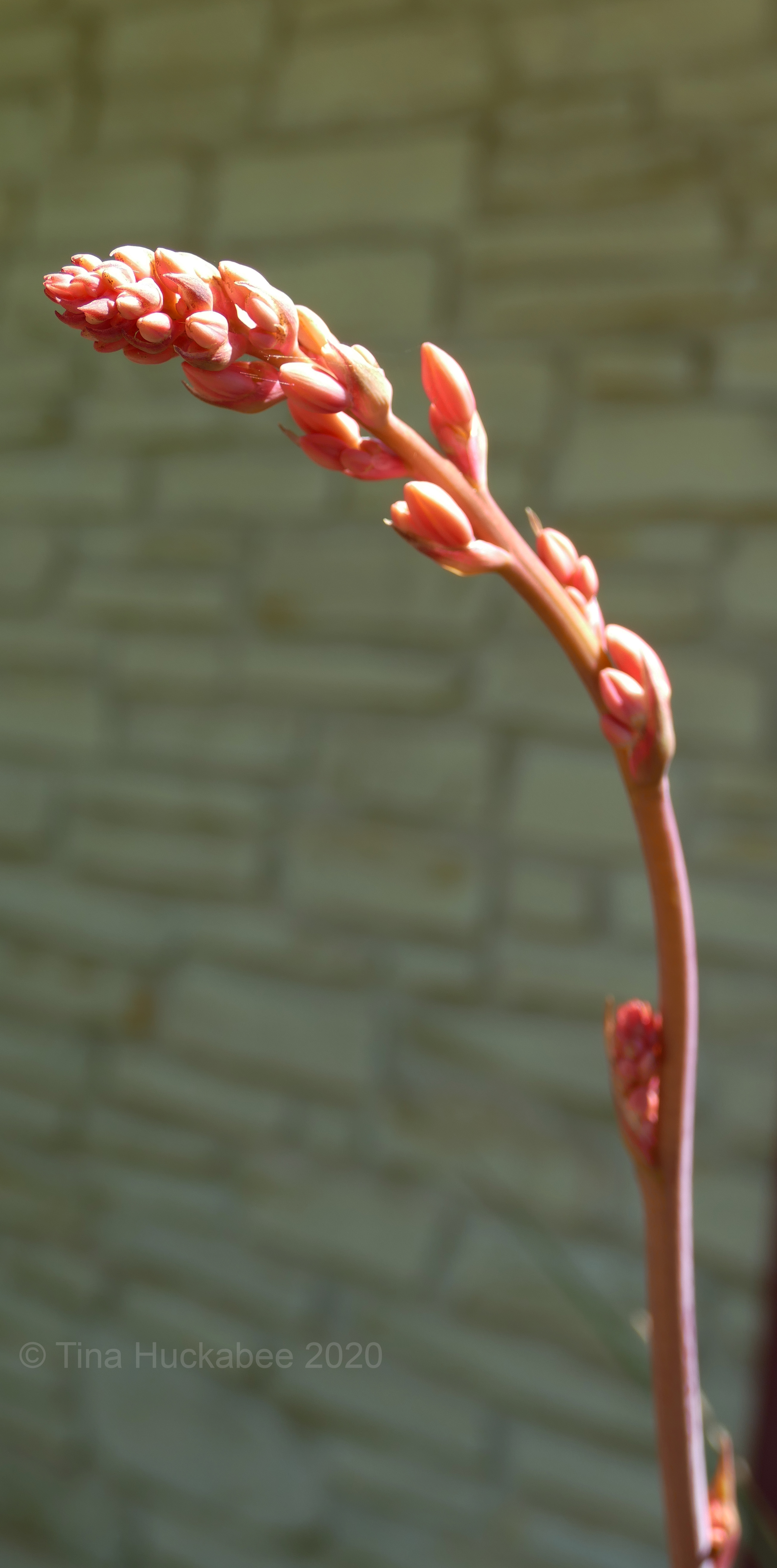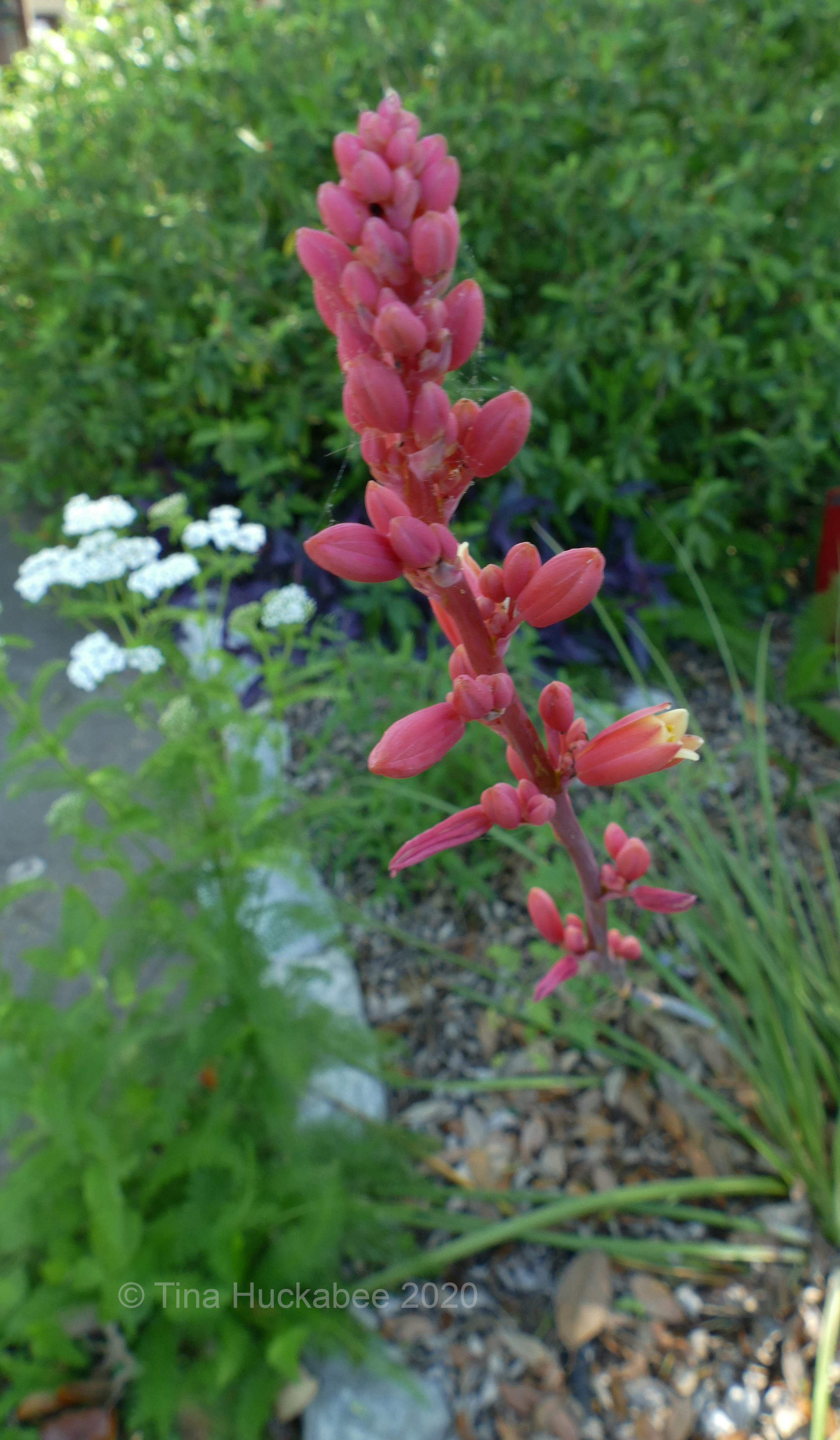Splayed and twisted describes so much of life at the moment, but in the garden, splayed and twisted are often normal happenings.
The scarlet and gold fluted flowers of Coral honeysuckle, Lonicera sempervirens, span outwards and downwards, trumpeting their beauty and wildlife value. Each await visits from their pollinator partners.
Some of the cheekier visitors steal nectar, rather than fulfilling pollinator expectations.
Nevertheless, I’m certain that eventually native bees, butterflies, moths, or birds will happen by to sip the good stuff from the tubular openings and carry pollen grains to parts unknown.
I grow several Red yucca, Hesperaloe parviflora, plants and all are pushing up their bloom stalks, daily and at a rapid pace, for this season’s bloom show. This one is reaching for the clouds, but hampered by its twisted ways.
Just beginning its push skyward, the curvy anomaly, known as fasciation, has kicked in. It’s unknown why stems occasionally go wavy-gravy or flowers turn into two-headed floral freaks, but it happens. It’s not a big deal in the plant world, because fasciation isn’t generally indicative of a spreading disease event or a genetically inferior plant. When the weird wonder occurs in the garden on a stem or flower head, it’s easily remedied by pruning out the botanical boo-boo. Or the gardener may leave it, as an acknowledgement of life’s vicissitudes.
I don’t plan to prune this stalk because even if it doesn’t grow-up straight or arched like its sibling stalks, pollinators (with the possible exception of hummingbirds) will find the flowers. Aside from Red yucca’s beauty to my eyes, the attraction to pollinators is the reason these perennials have a place in my garden.
The curvy one’s neighbor, an offshoot of the same mother plant, has grown about 4 feet tall. Single blooms, arrayed along the stalk, will soon open.
In a different part of the garden, another of the same species is bursting at its petals with salmon-hued goodness, ready for the winged-things to feed from.
The garden provides surprises, mostly good, always fascinating.
I’m joining in with Anna for Wednesday Vignette, check out her lovely Flutter and Hum for garden stories–the funny, the weird, the wonderful. Also, it’s April Bloom Day! So Carol’s gorgeous May Dreams Garden celebrates blooms –pop over to enjoy blooms from many places.






We tried coral honeysuckle once but the deer wouldn’t leave it alone. Fasciation is always cool!
LikeLike
Oh, that’s too bad. I don’t have deer to contend with, so I’m always surprised at what they’ll eat. Fasciation really is fascinating!!
LikeLike
I don’t have any yucca, so I enjoy seeing pictures of that. What an interesting bloom. And what an excellent word – vicissitudes!
LikeLike
I grow three native yucca (native to Texas) and one species that is native to more eastern parts of the U.S. I’m not really a fan of spiky plants generally, but the yucca are all somewhat tame, the Red yucca isn’t really pokey at all.
LikeLike
Is the coral honeysuckle a wild specimen or a garden cultivar? That is a species I never saw while within the native range in Oklahoma. It is available in nurseries here, but does not look like much.
LikeLike
Yes, the Coral honeysuckle is native to this region. Lovely blooms, tough plant, no fragrance. Two outta three ain’t bad!
LikeLiked by 2 people
I wanted it because it was native to the region of Oklahoma we were in; but I never found it growing anywhere, so left without cuttings. I thought it was strange that it was available in nurseries here for a while. I thought I was the only one around who wanted it! There is one at work, although I actually did not plant it. I still would have preferred to grow a wild one though.
LikeLiked by 1 person
I have never heard of fascination. Quite fascinating! I live in Massachusetts; I’ll have to look up the viability of that beautiful red yucca. So far my honeysuckle is just leafing out. I do love it because it blooms most of the summer.
LikeLike
Pat, I’m afraid this yucca is specifically a Texas thing. It is beautiful and native to our region. You might find it, or maybe a cultivar, but I wonder if it would stand up to your winters? Anyhow, here’s a link to the Lady Bird Johnson Wildflower Center’s information on this yucca. https://www.wildflower.org/plants/result.php?id_plant=hepa8
I’d be interested in how it does for you, if you find and grow it. Good luck!
LikeLike
I have noticed that many of the big bees in my yard go through the back end of the flower. Maybe they are too big to enter the other way. My bottlebrushes are loaded with bees.
LikeLike
Ha! I never thought about whether it’s the size of the bee that matters. I just thought some of them are thieving scoundrels. 🙂
LikeLiked by 1 person
May we all sometimes feel free to let our two-headed floral freak flags fly.
LikeLike
Lol. Yes!!
LikeLiked by 1 person
Your garden must be a hummingbird haven! There’s something about the scarlet and warm coral color schemes that attracts me, along with the hummers. Yum.
LikeLike
It is, though I don’t generally put up feeders for them. There are enough flowers that they like, that they won’t come to a feeder. So they’re actually in the garden, rather than coming up to the patio. I saw my first hummer yesterday as I was on a walk. It flew past me from one house to another, just around the corner from my house. Weeeee!
LikeLiked by 1 person
Love the coral honeysuckle and red yucca. I have never planted the red yucca but have always wanted to do so. Your garden is coming right along and I know it must be a lovely diversion for you.
LikeLike
Yes, they’re both gorgeous and work well together, too. It’s been such a lovely spring, amidst the dark clouds that surround; it’s reaffirming to see life move forward on its normal cycle.
LikeLiked by 1 person
Today is a day of celebration for my formerly ailing Hesperaloe. Understandably, it didn’t like even the sunniest place I had to offer it in my home garden, so today, I planted it in my new community garden plot – in full hot sun! I can’t wait to see it recover, and maybe even form a flower stalk. Yours are beautiful, and I agree. I think the fasciation adds additional interest. I have a nursery-rejected fasciated rose planted in the community garden too – such an oddball! I just can’t help loving it!
LikeLike
You and I, we like our oddballs! I love that word; my mom used it frequently (for me?? 🙂 ), but I rarely use it. Anyhow, yes, the yucca will like the sunny spot where you planted it. Wishing it many bloom stalks and long life!
LikeLiked by 1 person
Fingers crossed! I bet it thinks it hit the jackpot.
LikeLike
Beautiful closeup of the coral honeysuckle.
LikeLike
Thanks, Jason!
LikeLiked by 1 person
It intrigued me that you called the twisted stem ‘fasciated.’ I’ve always associated the condition with flattened stems and banded flowers, but never with that kind of twisting. Most of the articles I found when I first was looking for information mentioned the flattening, and I never looked further.
What occurs to me now is that the abundance of extra petals I found on the white prickly poppy might well be fasciation. That was the only thing that seemed like a decent explanation for me, and yet I didn’t think they really fit the definition. Now, I’m reconsidering!
LikeLike
I like the twisty red yucca stalk, though I’m also not sure that it’s an instance of fasciation.
LikeLike
I’m not sure that you’re not correct. 🙂 It doesn’t have that flattened business that fasciation usually shows, but I’ve never seen that curvy growth pattern in any of my yucca. I noticed yesterday that another one shows the same thing, though not nearly as curvy.
LikeLike
I found this article from the Denver Botanical Garden, but if you look closely at the stem of that yucca, it seems to show flattening as well as twist. I found other examples from some university sites that also show spiraling stems, but they’re also flattened. If yours still is around, does the stem show flattening? Or any other signs of fasciation, like doubled flowers? I do love these oddities!
LikeLike
I’m not positive that it is fasciated, but I went with that definition because I haven’t seen the curvy stalks before. Fasciation does usually exhibit as flattened and the yucca are clearly not. Last fall, I saw a stem of Salvia guaranitica that was definitely very twisted and very flattened.
LikeLike
Truthfully, I’m not sure, but I went with fasciation, just because I haven’t seen my yucca do that before. I thought your multi-petals were probably a good example. But, I’m no botanist–just a girl with a trowel.
LikeLiked by 1 person
I’m surely no botanist — that’s why so many of my opinions are provisional and subject to revision. What I do know for certain is that I had an indigo bunting at my feeders yesterday. I couldn’t believe it — but the migration clearly has started. Flocks of them have been sighted on Galveston Island, in a little park down by the Coast Guard station, and I do believe I might have to venture down there this weekend. Some of the best birding places are closed, but that one’s open, and it would be a treat to see them.
LikeLike
Wowzer!! I’ve never seen an Indigo Bunting! Yes, migratory season is in full swing. Didn’t see much today but yesterday, we had a Painted Bunting, Summer Tanager (they always come this time of year to eat bees!), a White-eye Vireo, and a Tennessee Warbler. No Indigo, but pretty decent runner-ups!
Oh, I hope you get to see the Indigos and do take loads of photos!!!
LikeLike
“Fluted flowers” has both rhythm and alliteration going for it. One place I’ve reliably found coral honeysuckle over the years is the pond at the Arbor Walk on the east side of Mopac. You’re fortunate not to have to go even that far.
LikeLike
I’ve enjoyed my Coral honeysuckle. Neither of the two I have bloom as much as they once did, as the amount of shade has increased. I’ve seen it in the wild, but the “best” (thickest, most blooming) specimens seem to grow in cultivated gardens. All that water and compost I guess.
LikeLike